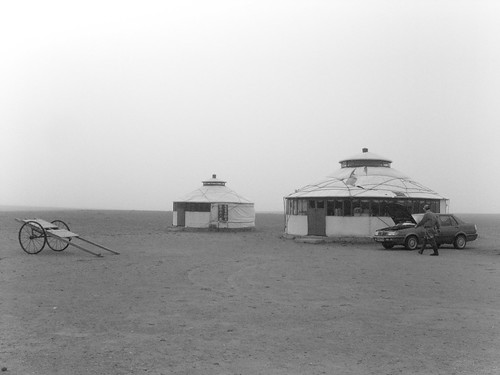ULAANBAATAR — Winter is already falling on Ulaanbaatar, Mongolia, and the sight of the greyish smoke rising from yurts in the suburbs of the coldest capital city on Earth is enough to worry 29-year-old Bolormaa Oyunbileg.
“As soon as the hard season begins, things become terrible,” she complains. “Often, we can’t even see the cars at the end of the street anymore.”
This is because of the coal stoves Mongolians use to heat their yurts. Ryan Allen, environmental health researcher at Simon Fraser University (British Columbia, Canada) and author of one of the rare studies on pollution-linked mortality in Ulaanbaatar, attributes one in 10 deaths in the “coal city” to pollution.
The traditional Mongolian shelter is renowned for its capacity to protect nomad families from the cold in the steppes. A stove in the center heats the only room, the shape of which allows for the heat to spread. With 60% of Ulaanbaatar’s 2.8 million inhabitants living in yurts, the issue has become a matter of public health.
Toxic fog
During the harshest winters, travelling shepherds are forced to settle down in the slums surrounding Ulaanbaatar. According to a 2010 census, between 30,000 and 40,000 people occupy these slums every year. If the winter is a particularly harsh one, a family can lose its entire herd of cattle. When this happens, the whole group takes to the road and moves near the capital, hoping to find jobs.
This is what Bolormaa and her husband had to do six years ago. They left the region near Lake Khuvsgul, one of Mongolia’s northernmost spots. At least in the capital, her husband is employed part-time in construction — but they’d prefer to return to rural life. “The smoke is thicker in the morning and in the evening when people cook,” Bolormaa says. “During the whole season my throat hurts and I can't stop coughing. I have a baby, and I fear for her health.” At dawn during December and January, when the outside temperature is -30 °C (-22 °F), the city disappears in this toxic fog.

Smog in Mongolia — Photo: Cory M. Grenier
In December 2011, the World Bank concluded that the exposure in Ulaanbaatar to particulate matter was 10 times higher than the standard for air quality in the country, and six to seven times higher than what the World Health Organization recommends. According to the World Bank, there is no doubt that the Mongolian city is the most polluted capital on the planet.
In the Sharkhad neighborhood, Tuya Gerel, who has been the doctor at the free clinic for three years, says she noticed a surge in the number of respiratory problems, coughing syndromes and allergies. “But it’s difficult to say with certainty whether each case was caused by coal,” she says. “I must say that some of my patients have predispositions.” Oyuna Bata, a local social welfare worker, is not so cautious: “There are no figures, but there are more and more miscarriages, and more and more newborns with pulmonary problems.”
“In my family, everybody coughs”
Thanks to support from international development agencies, the Mongolian government recently implemented a program to help families buy more efficient stoves that use less coal. The stove price for families has fallen from $240 to $35.
Oyuna Bata says some families have availed themselves of the new stoves, but others have different budget priorities and seem resigned to poor air quality. Also, in the winter, the whole neighborhood buys the cheapest, poorest quality coal from a mine in Baganuur, 130 kilometers east of the city. Forty kilos cost the equivalent of $2, but it burns faster and creates much more toxic smoke. “In my family, everybody coughs, and even those who don’t smoke have black lungs,” Oyuna Bata says angrily.
Year after year, Bolormaa’s neighbor, 62-year-old Gantuya Damdin, has seen the air quality of the city worsen. As long as these yurt slums, which are not connected to the central heating system, grow, she doesn’t see how the capital of the “land of the blue sky” can rid itself of this black halo.





